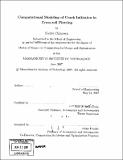| dc.contributor.advisor | Raúl A. Radóvitzky. | en_US |
| dc.contributor.author | Chiluveru, Sudhir | en_US |
| dc.contributor.other | Massachusetts Institute of Technology. Computation for Design and Optimization Program. | en_US |
| dc.date.accessioned | 2007-10-22T17:36:16Z | |
| dc.date.available | 2007-10-22T17:36:16Z | |
| dc.date.copyright | 2007 | en_US |
| dc.date.issued | 2007 | en_US |
| dc.identifier.uri | http://hdl.handle.net/1721.1/39325 | |
| dc.description | Thesis (S.M.)--Massachusetts Institute of Technology, Computation for Design and Optimization Program, 2007. | en_US |
| dc.description | Includes bibliographical references (p. 81-89). | en_US |
| dc.description.abstract | Thle Mannesmann process is the preferred method in the oil industry for fabrication of hollow pipes. The critical phenomenon in this process is the formation of a small round hole at the center of the cylindrical billet ahead of the piercing plug. In this work the crack initiation that leads to the creation of tile small hole has been modeled. The Gurson-Tvergaard-Needlemnan model of porous plasticity is used to simulate the Mannesmann effect. The appearance of a crack at the center of the cylindrical bar is demonstrated and the stress profiles, plastic equivalent strain profiles and porosity distribution during the deformation process are analyzed. The influence of various parameters in the model on the evolution of porosity in tile specimen is studied. Other simple ductile fracture criteria that are proposed in literature are also implemented. An interface model for fracture using the discontinuous Galerkin framework combined with a cohesive fracture law is implemented. This approach and its advantages are illustrated in the application of tensile loading of a simple beam specimen. | en_US |
| dc.description.statementofresponsibility | by Sudhir Chiluveru. | en_US |
| dc.format.extent | 89 p. | en_US |
| dc.language.iso | eng | en_US |
| dc.publisher | Massachusetts Institute of Technology | en_US |
| dc.rights | M.I.T. theses are protected by copyright. They may be viewed from this source for any purpose, but reproduction or distribution in any format is prohibited without written permission. See provided URL for inquiries about permission. | en_US |
| dc.rights.uri | http://dspace.mit.edu/handle/1721.1/7582 | |
| dc.subject | Computation for Design and Optimization Program. | en_US |
| dc.title | Computational modeling of crack initiation in cross-role piercing | en_US |
| dc.type | Thesis | en_US |
| dc.description.degree | S.M. | en_US |
| dc.contributor.department | Massachusetts Institute of Technology. Computation for Design and Optimization Program | |
| dc.identifier.oclc | 173399428 | en_US |
